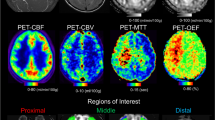Abstract
Background
The prevalence of ivy sign on fluid-attenuated inversion recovery (FLAIR) imaging in patients with asymptomatic moyamoya disease is unclear. The aim of this study was to clarify the incidence of ivy sign in these patients, as well as the correlation between MRI and 15O gas PET findings.
Methods
A retrospective analysis including 16 consecutive patients with asymptomatic moyamoya disease enrolled between 2001 and 2010 in a single center. FLAIR imaging at the initial visit was categorized as ivy sign present, negative, or equivocal. Hemodynamic and metabolic parameters were quantified in 11 of 16 patients by 15O-gas positron emission tomography, and the relationship between ivy sign and 15O-gas PET parameters was analyzed. Cerebrovascular events within the follow-up period (54 ± 28 months) were also examined.
Results
Five of 16 asymptomatic moyamoya patients (31.3 %) had positive ivy sign (6/30 hemispheres, 20 %). In 15O-gas PET examinations, 18 % of 22 hemispheres had elevated oxygen extraction fraction values that were significantly associated with positive ivy sign. Of these 16 asymptomatic moyamoya patients, six patients (37.5 %) underwent combined surgical revascularization. In this series, no patients experienced ischemic stroke, but one had intraventricular bleeding 1 year after surgery.
Conclusions
Ivy sign on FLAIR imaging is still not rare in patients with moyamoya disease, even when asymptomatic. Although optimal management is still under debate, ivy sign may be an indicator of misery perfusion, and patients with asymptomatic moyamoya disease and ivy sign on FLAIR imaging will benefit from more careful follow-up.




Similar content being viewed by others
References
Azizyan A, Sanossian N, Mogensen MA, Liebeskind DS (2011) Fluid-attenuated inversion recovery vascular hyperintensities: an important imaging marker for cerebrovascular disease. AJNR Am J Neuroradiol 32:1771–1775
Baron JC, Bousser MG, Rey A, Guillard A, Comar D, Castaigne P (1981) Reversal of focal “misery-perfusion syndrome” by extra-intracranial arterial bypass in hemodynamic cerebral ischemia. A case study with 15O positron emission tomography. Stroke 12:454–459
Derdeyn CP, Videen TO, Yundt KD, Fritsch SM, Carpenter DA, Grubb RL, Powers WJ (2002) Variability of cerebral blood volume and oxygen extraction: stages of cerebral haemodynamic impairment revisited. Brain 125:595–607
Fujimura M, Tominaga T (2012) Lessons learned from moyamoya disease: outcome of direct/indirect revascularization surgery for 150 affected hemispheres. Neurol Med Chir (Tokyo) 52:327–332
Fujiwara H, Momoshima S, Kuribayashi S (2005) Leptomeningeal high signal intensity (ivy sign) on fluid-attenuated inversion-recovery (FLAIR) MR images in moyamoya disease. Eur J Radiol 55:224–230
Hokari M, Kuroda S, Shiga T, Nakayama N, Tamaki N, Iwasaki Y (2008) Combination of a mean transit time measurement with an acetazolamide test increases predictive power to identify elevated oxygen extraction fraction in occlusive carotid artery diseases. J Nucl Med 49:1922–1927
Houkin K, Ishikawa T, Yoshimoto T, Abe H (1997) Direct and indirect revascularization for moyamoya disease surgical techniques and peri-operative complications. Clin Neurol Neurosurg 99(Suppl 2):S142–S145
Houkin K, Nakayama N, Kuroda S, Nonaka T, Shonai T, Yoshimoto T (2005) Novel magnetic resonance angiography stage grading for moyamoya disease. Cerebrovasc Dis 20:347–354
Ideguchi R, Morikawa M, Enokizono M, Ogawa Y, Nagata I, Uetani M (2011) Ivy signs on FLAIR images before and after STA-MCA anastomosis in patients with Moyamoya disease. Acta Radiol 52:291–296
Kawashima M, Noguchi T, Takase Y, Nakahara Y, Matsushima T (2010) Decrease in leptomeningeal ivy sign on fluid-attenuated inversion recovery images after cerebral revascularization in patients with Moyamoya disease. AJNR Am J Neuroradiol 31:1713–1718
Kawashima M, Noguchi T, Takase Y, Ootsuka T, Kido N, Matsushima T (2009) Unilateral hemispheric proliferation of ivy sign on fluid-attenuated inversion recovery images in moyamoya disease correlates highly with ipsilateral hemispheric decrease of cerebrovascular reserve. AJNR Am J Neuroradiol 30:1709–1716
Kuroda S, Hashimoto N, Yoshimoto T, Iwasaki Y (2007) Radiological findings, clinical course, and outcome in asymptomatic moyamoya disease: results of multicenter survey in Japan. Stroke 38:1430–1435
Kuroda S, Houkin K, Ishikawa T, Nakayama N, Iwasaki Y (2010) Novel bypass surgery for moyamoya disease using pericranial flap: its impacts on cerebral hemodynamics and long-term outcome. Neurosurgery 66:1093–1101, discussion 1101
Kuroda S, Shiga T, Houkin K, Ishikawa T, Katoh C, Tamaki N, Iwasaki Y (2006) Cerebral oxygen metabolism and neuronal integrity in patients with impaired vasoreactivity attributable to occlusive carotid artery disease. Stroke 37:393–398
Maeda M, Tsuchida C (1999) “Ivy sign” on fluid-attenuated inversion-recovery images in childhood moyamoya disease. AJNR Am J Neuroradiol 20:1836–1838
Mori N, Mugikura S, Higano S, Kaneta T, Fujimura M, Umetsu A, Murata T, Takahashi S (2009) The leptomeningeal “ivy sign” on fluid-attenuated inversion recovery MR imaging in Moyamoya disease: a sign of decreased cerebral vascular reserve? AJNR Am J Neuroradiol 30:930–935
Noguchi T, Kawashima M, Irie H, Ootsuka T, Nishihara M, Matsushima T, Kudo S (2011) Arterial spin-labeling MR imaging in moyamoya disease compared with SPECT imaging. Eur J Radiol 80:e557–e562
Ohta T, Tanaka H, Kuroiwa T (1995) Diffuse leptomeningeal enhancement, “ivy sign,” in magnetic resonance images of moyamoya disease in childhood: case report. Neurosurgery 37:1009–1012
Pandey P, Steinberg GK (2011) Neurosurgical advances in the treatment of moyamoya disease. Stroke 42:3304–3310
Powers WJ, Grubb RL Jr, Raichle ME (1984) Physiological responses to focal cerebral ischemia in humans. Ann Neurol 16:546–552
Sanossian N, Saver JL, Alger JR, Kim D, Duckwiler GR, Jahan R, Vinuela F, Ovbiagele B, Liebeskind DS (2009) Angiography reveals that fluid-attenuated inversion recovery vascular hyperintensities are due to slow flow, not thrombus. AJNR Am J Neuroradiol 30:564–568
Suzuki J, Takaku A (1969) Cerebrovascular “moyamoya” disease. Disease showing abnormal net-like vessels in base of brain. Arch Neurol 20:288–299
Yoon HK, Shin HJ, Chang YW (2002) “Ivy sign” in childhood moyamoya disease: depiction on FLAIR and contrast-enhanced T1-weighted MR images. Radiology 223:384–389
Conflicts of interest
None.
Author information
Authors and Affiliations
Corresponding author
Additional information
Sandra V and Masaki I contributed equally to the present manuscript.
Rights and permissions
About this article
Cite this article
Vuignier, S., Ito, M., Kurisu, K. et al. Ivy sign, misery perfusion, and asymptomatic moyamoya disease: FLAIR imaging and 15O-gas positron emission tomography. Acta Neurochir 155, 2097–2104 (2013). https://doi.org/10.1007/s00701-013-1860-4
Received:
Accepted:
Published:
Issue Date:
DOI: https://doi.org/10.1007/s00701-013-1860-4




